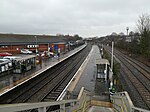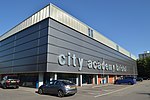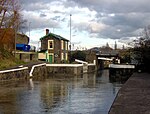Barton House, Bristol
Brutalist architecture in the United KingdomBuildings and structures in BristolResidential buildings completed in 1958Residential skyscrapers in England

Barton House is a residential tower block in the Barton Hill area of Bristol, England. It is the city's oldest tower block and was officially opened on 23 July 1958.
Excerpt from the Wikipedia article Barton House, Bristol (License: CC BY-SA 3.0, Authors, Images).Barton House, Bristol
Cotton Mill Lane, Bristol Redfield
Geographical coordinates (GPS) Address Nearby Places Show on map
Geographical coordinates (GPS)
| Latitude | Longitude |
|---|---|
| N 51.4539 ° | E -2.5608 ° |
Address
Cotton Mill Lane
BS5 9TZ Bristol, Redfield
England, United Kingdom
Open on Google Maps








